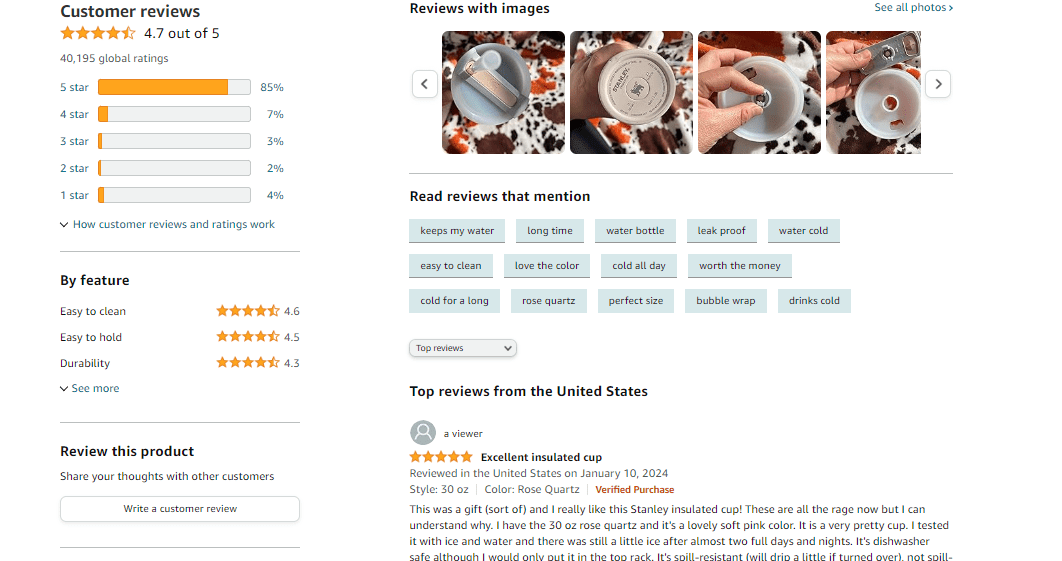How can a simple thumbs-up drive sales through the roof? Welcome to the world of social proof – a powerful marketing tool that leverages human psychology to boost conversions. At its core, social proof hinges on the idea that the actions and approvals of others influence people. When used carefully in advertising, this idea can persuade people to buy something, subscribe to a service, or interact with a brand.
Take, for instance, the fashion industry. When a celebrity endorses a new line of clothing, it creates a ripple effect – fans rush to emulate their style, leading to increased sales. Similarly, user reviews and ratings can make or break a product’s success in the tech world.

Key benefits of effectively using social proof include:
- Enhanced brand credibility
- Increased trust among potential customers
- Higher conversion rates
Think about utilizing Plerdy’s user behavior analysis tools to use social proof fully. Today’s market requires improving user experience and conversion rates.
Introduction to Social Proof: Definition and Basic Concept
Social proof stands as a cornerstone in the bustling marketplace of ideas and products, influencing consumer choices subtly yet powerfully. The invisible hand guides decisions, swaying opinions through the collective voice. In its essence, social proof is the psychological and social phenomenon where individuals emulate the actions of others, assuming these actions reflect the correct behavior in a given situation. This phenomenon manifests in various forms, from glowing customer testimonials to celebrity endorsements, each serving as a testament to a product’s value or a service’s quality.
Key aspects of social proof include:
- Leveraging user experiences to build credibility.
- Harnessing the power of influencer opinions.
- Utilizing user-generated content to foster trust.
Social proof transcends traditional marketing boundaries in the digital age, morphing into a multifaceted tool. It’s not just a strategy; it’s a testimonial to human behavior, echoing the communal nature of decision-making. Brands harnessing social proof tap into a reservoir of trust, using authentic experiences to paint their offerings in a trustworthy light. Whether it’s a tech startup boasting thousands of satisfied users or a fashion brand flaunting celebrity endorsements, social proof remains a linchpin in their marketing arsenal, shaping perceptions in a world where seeing is believing.
Types of Social Proof

Social proof, a key player in the marketing playbook, morphs into various forms, each uniquely tailored to different audience psychologies. This multifaceted approach ensures that social proof remains relevant and pivotal in a diverse array of marketing strategies.
- Celebrity Endorsements: The glamour of a celebrity’s endorsement serves as powerful social proof, leveraging their broad appeal to bolster a brand’s image.
- Customer Reviews and Testimonials: These personal narratives build a bridge of trust, showcasing real-life experiences and satisfaction.
- Expert Approvals: When a respected authority in a niche nods, it heightens the credibility of a product or service.
- User Statistics: Numbers don’t lie – showcasing user numbers or satisfaction rates provides tangible social proof.
- Social Media Influence: Likes, shares, and comments create a ripple effect, amplifying social proof through digital word-of-mouth.
Each type of social proof harnesses a unique facet of human psychology, from the allure of celebrity influence to the reassuring solidity of user statistics, weaving a tapestry of trust and credibility. These varied forms of social proof converge in the digital age, creating a robust framework for brands to engage and convince their target audience.
The Psychology Behind Social Proof
At its core, social proof taps into the fundamental aspects of human psychology, shaping decisions and preferences in an often subtle dance of influence. This phenomenon leverages the innate human tendency to seek guidance from others, particularly in situations of uncertainty. Social proof serves as a psychological compass, pointing individuals toward choices validated by the crowd.
Key Psychological Aspects:
- Desire for Conformity: Social proof capitalizes on our natural inclination to fit in with others, ensuring our choices align with societal norms.
- Risk Aversion: By following the crowd, individuals minimize the perceived risk in decision-making.
- Informational Social Influence: Social proof acts as a beacon of trusted information, guiding decisions in a sea of options.
- Trust in Collective Wisdom: Numbers reassure; social proof assumes the majority is right.
From a marketing perspective, understanding this psychological underpinning is crucial. For instance, seeing a trend take off in fashion creates a domino effect as more people adopt it to stay in vogue. In tech, witnessing the widespread adoption of a new gadget can quell individual hesitations, nudging them towards purchase. Thus, social proof is more than a marketing tool—it reflects our social nature and influences customer behavior and decision-making.
Implementing Social Proof in Digital Marketing

In digital marketing, weaving social proof into your strategy is akin to adding a secret ingredient that transforms a good recipe into a great one. It’s about leveraging the power of collective endorsement to amplify your brand’s message and credibility.
Effective Ways to Implement Social Proof:
- Showcasing Customer Testimonials: Highlighting positive feedback on your website and social media channels.
- Utilizing User-Generated Content: Promoting client feedback and content.
- Leveraging Influencer Partnerships: Collaborating with influencers to reach a wider audience.
- Displaying Trust Badges and Certifications: Add credibility with credentials or qualifications from respectable organizations.
- Highlighting Media Mentions and Coverage: Sharing any press or media features your brand has received.
In fashion and tech, product reviews and influencer collaborations can impact shoppers. Implementing social proof in digital marketing isn’t just about showing numbers or testimonials; it’s about creating a narrative where your product or service is the protagonist, backed by a chorus of satisfied users. This strategy builds trust and fosters a community around your brand, making social proof an indispensable tool in the digital marketer’s toolkit.
Strategies for E-commerce Websites
In the bustling digital bazaar of e-commerce, leveraging social proof is akin to shining a spotlight on your products, beckoning shoppers to take a closer look. For e-commerce websites, using social proof can transform browsers into buyers, building a foundation of trust and credibility.
Effective Strategies:
- Featuring Customer Reviews Prominently: Displaying reviews and ratings on product pages to offer real-user insights.
- Highlighting Best-Sellers: Showcasing popular items to indicate proven choices among customers.
- Using Social Media Proof: Sharing user-generated content and testimonials from social media platforms.
- Implementing Trust Badges: Displaying security badges and endorsements to enhance trustworthiness.
- Creating a Community Feel: Encouraging and sharing customer stories, photos, and experiences.
In niches like fashion or tech gadgets, where choice is abundant, these strategies help products stand out. They provide shoppers with a sense of security and belonging, knowing they are making a choice backed by a community. Implementing social proof in e-commerce is not just about displaying evidence but weaving a narrative of trust and reliability, turning each visit into a potential success story.
Leveraging Social Proof in Email Marketing
In email marketing, infusing your messages with social proof is like adding a secret spice that makes your content irresistible. When emails echo the voices of satisfied customers or flaunt the numbers of happy users, they turn from mere messages into compelling narratives of success and trust.
Social Proof in Email Strategy:
- Incorporating Testimonials: Weaving customer testimonials into the email body to showcase real experiences.
- Highlighting User Milestones: Sharing statistics or milestones to demonstrate the widespread use and satisfaction.
- Featuring Case Studies: This includes brief case studies highlighting customer success stories.
- Showcasing Media Mentions: Mentioning any press or media attention to add credibility.
- Using Influencer Endorsements: Adding quotes or endorsements from industry influencers or celebrities.
In various niches, like health and wellness or tech gadgets, these strategies transform emails from simple promotions to persuasive engagement tools. They give readers a glimpse of others’ experiences, tapping into the social aspect of decision-making. In email marketing, social proof is used to engage with readers and create a sense of belonging in a happy community.
Social Proof in Content Marketing and SEO

In the intricate dance of content marketing and SEO, social proof acts as a dynamic partner, boosting credibility and engagement. It’s a potent blend that informs and persuades, leveraging the collective nod of approval to enhance visibility and trust.
Integrating Social Proof into SEO and Content Marketing:
- Incorporating Customer Reviews in Content: Embedding authentic reviews within blog posts or articles.
- Showcasing User Testimonials on Landing Pages: Using real stories to add a human touch to SEO-optimized pages.
- Highlighting Case Studies and Success Stories: Demonstrating real-world applications and results.
- Featuring Influencer Collaborations: Including mentions or content created in partnership with influencers.
- Utilizing User-Generated Content: Leveraging user-generated content as part of the SEO strategy.
In niches like travel or lifestyle, where personal experience is king, this approach enriches the content and boosts its search engine rankings. Social proof is a strategy that bridges data-driven optimization and narrative in content marketing and SEO. It’s about creating content that resonates, not just with algorithms, but with real people, driving traffic and trust.
Using Social Proof in Pay-Per-Click (PPC) Campaigns
In the high-stakes arena of Pay-Per-Click (PPC) campaigns, social proof isn’t just an element; it’s a game-changer. When woven into PPC strategies, social proof transforms ads from mere pitches into compelling stories of user satisfaction and trust.
Successful PPC Social Proof Uses:
- Incorporating User Testimonials: Adding customer quotes to ad copy to lend authenticity.
- Showcasing User Statistics: Using data like customer counts or satisfaction rates to bolster credibility.
- Highlighting Awards and Recognitions: Mentioning any accolades to reinforce authority and excellence.
- Featuring Influencer Endorsements: Including endorsements from known personalities for added appeal.
- Displaying Trust Badges: Add badges from renowned organizations to boost reputation.
These techniques can be the deciding factor in markets like tech gadgets or health and wellness, where consumers are bombarded with choices. Leveraging social proof in PPC campaigns isn’t just about boosting click-through rates; it’s about crafting a narrative that resonates with the audience, ensuring that others have tread this path successfully. This approach captivates attention and fosters a deeper connection, turning clicks into conversions through the power of shared experiences and validated choices.
Best Practices for Effective Social Proof
Social proof may propel your brand like a river if used properly. The key lies in balancing authenticity and strategic presentation, ensuring that social proof resonates genuinely with your audience.
Essential Best Practices:
- Authenticity is Paramount: Genuine testimonials and reviews build trust. Avoiding fabricated or overly edited content keeps the social proof credible.
- Diverse Sources of Social Proof: Including a mix of customer testimonials, expert endorsements, and user statistics caters to varied audience preferences.
- Contextual Relevance: Tailoring social proof to fit the context and audience of the product or service enhances its impact.
- Timely Updates: Regularly refreshing social proof keeps it relevant and reflects the customer experience.
- Strategic Placement: Positioning social proof on key conversion points of a website, such as landing pages or checkout, maximizes its effectiveness.
In niches like the beauty industry, where trust is crucial, showcasing user before-and-after photos can be highly persuasive. User statistics and professional reviews help tech purchasers make informed judgments. The art of effective social proof lies in what is presented and how it’s woven into the customer’s journey. It’s a blend of art and psychology, where the right word or image can turn skepticism into trust and interest into action. This approach doesn’t just sell a product or service; it builds a narrative where each customer becomes part of a larger, satisfied community.
Measuring the Impact of Social Proof

Social proof measurement in digital marketing is like solving a difficult but rewarding puzzle. It’s about turning qualitative endorsements into quantifiable metrics, ensuring that the influence of social proof on consumer behavior and business success is felt and seen in tangible results.
Key Metrics to Track:
- Conversion Rates: Observing changes in conversion rates after implementing social proof.
- Engagement Metrics: Tracking likes, shares, comments, and overall interaction with social proof elements.
- Customer Feedback and Reviews: Monitoring the volume and sentiment of customer reviews.
- Website Analytics: Analyzing bounce rates, time on site, and pageviews on pages featuring social proof.
- A/B Testing: Comparing performance between versions of content with and without social proof.
In industries like fashion or consumer electronics, a surge in engagement or a notable decrease in bounce rates can directly correlate with well-placed social proof. Social proof influences consumer perceptions and decisions, not just a trend. Marketers can fine-tune their strategies by focusing on these key metrics, turning the subtle art of social influence into a cornerstone of their digital success. This approach goes beyond superficial analysis, delving into how social proof weaves its magic across different platforms and consumer touchpoints.
Challenges and Limitations of Social Proof
Navigating the waters of social proof in marketing has its challenges and limitations. While it’s a powerful tool for influencing consumer behavior, relying solely on social proof can lead to pitfalls that may undermine its effectiveness.
Key Challenges and Limitations:
- Overdependence on Social Proof: Excessive reliance can lead to a lack of differentiation, where products or services lose their unique appeal.
- Authenticity Concerns: In an era of skepticism, consumers might question the genuineness of overly positive reviews or endorsements.
- Negative Social Proof: Poor reviews or negative social media buzz can harm a brand’s reputation more than social proof can enhance it.
- One-Size-Fits-All Approach: Not all types of social proof work equally well across different industries or demographics.
- Saturation Point: Social proof can become white noise in markets with many endorsements.
Influencer endorsements can start fashion trends, but misuse can cause consumer fatigue and distrust. Overexposure of comparable tech expert reviews can reduce their influence. Using social proof to complement other marketing methods without overshadowing the product or service’s value requires balance and authenticity. This nuanced technique uses social proof’s strengths and weaknesses to construct a realistic story for the intended audience.
Future Trends in Social Proof
Peering into the future of social proof, we see a landscape ripe with innovation and adaptation. As technology evolves, so will the ways social proof is leveraged and perceived, shaping consumer behavior and marketing strategies.
Emerging Trends in Social Proof:
- Increased Personalization: Tailoring social proof to individual preferences and browsing history for a more personalized experience.
- Integration with Artificial Intelligence: Utilizing AI to analyze and present social proof more effectively and contextually.
- Augmented Reality Experiences: Offering immersive experiences that blend real-world testimonials with augmented reality.
- Rise of Micro-Influencers: Shifting focus from celebrity endorsements to more relatable micro-influencers.
- Blockchain for Authenticity: Using blockchain technology to verify the authenticity of reviews and testimonials.
These advancements in sectors like e-commerce and tech gadgets will redefine how social proof is gathered and presented. Imagine an online shopping experience where augmented reality lets you see how others in your demographic enjoyed a product or AI algorithms that display reviews most relevant to your specific interests. The future of social proof lies in its ability to adapt, becoming more interactive, personalized, and trustworthy. This evolution will enhance its impact and redefine the concept of social influence in the digital age.
Conclusion
Modern marketers use social evidence to build trust and credibility. Explain how your product fits into real people’s stories. Effective marketing uses social proof, as explained in this essay.
Consider these key takeaways:
- Social proof builds a bridge of trust between brands and their audience.
- It showcases the human side of your product, making it relatable and desirable.
- Leveraging social proof can catapult your brand into the spotlight, driving conversions and fostering brand loyalty.
As you step forward, remember that the art of using social proof is as diverse as the market itself. From engaging social media posts to comforting website testimonials, everything matters. When paired with advanced tools like Plerdy, which offers in-depth analysis of user behavior and preferences, you’re not just guessing – strategically placing every testimonial, review, and influencer shout-out where it will have the most impact.
Mastering social proof is about understanding and utilizing human connection, not just using a marketing tool. Explore its depths and witness as it changes your audience connection, one social proof at a time.
